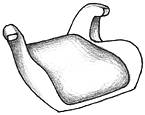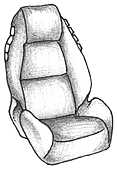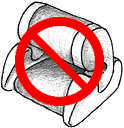|
Booster seats come in a variety of styles, sizes, and prices.
There are different types to fit the needs of your car and there
are different types to fit the needs of your growing child. The
important thing is to find a booster seat that fits your child right.
The Basics
Types of Booster Seats
Find a Seat That Fits Your Child
Seats for Children with Special Needs
Booster Seats to Avoid
The Basics
- You need to have a lap and shoulder belt to use a booster seat.
- Your child needs to be over 40 pounds to use a booster seat.
- Your child's head always needs to be protected against whiplash.
Make sure the booster seat or your car's headrest comes up above
his ears when he is using the booster seat.
- A higher price does not mean the seat is safer or fits better.
Back to Top
Types of Booster Seats
There are 3 types of booster seats that protect children in
car crashes. You should always follow your booster seat manufacturer's
instructions for each seat. Pay attention to the weight limits
listed on the seat label.
No-back Booster Seat
 |
- Must be used with a lap and shoulder belt.
- Your car's seats need to have headrests that come above
your child's ears when she is sitting in a no-back booster
seat.
- No-back booster seats are easy to pack up and move from
one car to another
|
|
High-back Booster Seat
- Must be used with a lap and shoulder belt.
- A high-back booster protects against whiplash in cars
with low-seatbacks.
- It can be used in cars with or without headrests.
- A high-back booster can be comfortable for a child who
likes to nap in the car.
|
 |
Forward-Facing Seat with Harness or Combination Seat
|

|
- This seat combines a car seat with a booster seat. It
allows your child to use the same seat as she grows up.
- If your child is between 20-40 pounds, attach the safety
seat to your car's seat with the seat belt and buckle
your child in with the harness.
- When your child weighs 40 pounds (or the upper weight
limit for the harness), remove the harness and detach
the safety seat from the car's seat. Now, you have a high-back
booster seat!
- Use the lap and shoulder seat belt to buckle your child
in safely.
- This type of booster seat can be used in cars with or
without headrests
|
Back to Top
Find a Seat for Your Child
Click here to find out what seat
is best for your child and your car.
Back to Top
Seats for Children with Special Needs
Some children may require a special safety seat to be protected
in the car. Talk with your child's doctor about the best type
of seat for his needs. The American Academy of Pediatrics also
has information about the different types of seats available.
Click
here to view a .pdf of the brochure.
(Note: You will need Adobe Acrobat Reader to open this .pdf document.
Adobe Acrobat Reader is free.)
Back to Top
Booster Seats to Avoid
Some seats are not recommended by doctors and safety experts.
Shield Booster Seats
|

|
- Using the shield portion of this booster seat is no
longer recommended. It may cause injury during a car crash.
- If the shield can come off, take it off. (Check the
seat's instruction book.)
Now, you have a no-back booster seat!
- Use the seat without the shield by buckling your child
in with the lap and shoulder belt.
- Your car's seats need to have headrests that come above
your child's ears when she is sitting in a no-back booster
seat.
- If the shield cannot come off, do NOT use this seat.
|
Recalled Seats
Some booster seats have been recalled by the manufacturer.
These seats should not be used. The National Highway Traffic
Safety Administration (NHTSA) has a listing of recalled seats.
Click
Here
Secondhand Seats
We do not recommend using secondhand seats that you find at
garage sales or thrift shops. The seats may have been in a crash
or may have been damaged. You may not be able to see the damage.
Do not use a booster seat unless you know its history.
Back to Top
|



